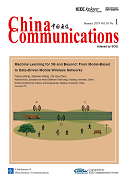REVIEW PAPERS
Ping Zhang, Xiaoli Yang, Jianqiao Chen, Yuzhen Huang
2019, 16(1): 69-85.
With the development of wireless communication technology, the fifth generation mobile communications system (5G) emerges at a historic moment and devotes itself to open the curtain of the information age. Recently, in order to satisfy the requirement of different applications, various advanced 5G technologies have been developed in full swing. However, before applying these 5G related technologies in practical systems, effective testing methods are needed to evaluate these technologies in a real, comprehensive, rapid and flexible manner. However, the testing methods are faced with new challenges along with the continuous development of the new 5G technologies. In this paper, we present a survey of 5G testing, including solutions and opportunities. In particular, two cases are considered, i.e., channel modelling and over-the-air (OTA) testing of antenna systems. Specifically, a non-stationary channel model is proposed to characterize and test massive multiple-input multiple-output (MIMO) channel. In addition, we propose two probe subset selection algorithms for three-dimensional (3D) OTA testing, which minimizes the number of probe antennas while ensuring the accuracy of the target channel emulation. Finally, future research directions and challenges on 5G testing are given.
